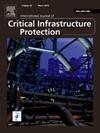Resilience of interdependent infrastructure networks: Review and future directions
IF 5.3
3区 工程技术
Q1 COMPUTER SCIENCE, INFORMATION SYSTEMS
International Journal of Critical Infrastructure Protection
Pub Date : 2025-08-21
DOI:10.1016/j.ijcip.2025.100793
引用次数: 0
Abstract
Interdependent infrastructure systems are instrumental for facility operations. Existing research has emphasised the resilience of infrastructure networks from theoretical to methodological perspectives. This paper aims to identify the current trends and future directions using a mixed method combining bibliometric analysis and systematic review. 101 highly relevant articles are selected for analysis, and scientific literature maps are constructed to analyse co-authorship, co-citation, and keywords. In addition, systematic review is conducted to identify the main research themes, including characteristics analysis of interdependent infrastructure resilience, resilience assessment, and improvement strategies. The potential avenues for future research are also identified, including developing data-driven, interpretable resilience models using advanced algorithms; analysing performance evolution mechanisms integrating temporal and geographic perspectives, assessing resilience emphasising dynamic equilibrium states; improving the holistic resilience considering the trade-off of different targets. This research contributes to the body of knowledge of interdependent infrastructure resilience and exposes the research needs in this area.
相互依赖的基础设施网络的弹性:回顾和未来方向
相互依赖的基础设施系统对设施运营至关重要。现有的研究从理论到方法的角度都强调了基础设施网络的弹性。本文旨在运用文献计量分析和系统综述相结合的方法,确定当前的趋势和未来的发展方向。选择101篇高度相关的文章进行分析,并构建科学文献图来分析共同作者,共同引用和关键词。此外,本文还进行了系统综述,确定了主要研究主题,包括相互依存基础设施弹性特征分析、弹性评估和改进策略。还确定了未来研究的潜在途径,包括使用先进算法开发数据驱动的可解释弹性模型;综合时间和地理角度分析绩效演化机制,评估强调动态平衡状态的弹性;考虑不同目标的权衡,提高整体弹性。本研究为基础设施相互依赖弹性的知识体系做出了贡献,并揭示了该领域的研究需求。
本文章由计算机程序翻译,如有差异,请以英文原文为准。
求助全文
约1分钟内获得全文
求助全文
来源期刊

International Journal of Critical Infrastructure Protection
COMPUTER SCIENCE, INFORMATION SYSTEMS-ENGINEERING, MULTIDISCIPLINARY
CiteScore
8.90
自引率
5.60%
发文量
46
审稿时长
>12 weeks
期刊介绍:
The International Journal of Critical Infrastructure Protection (IJCIP) was launched in 2008, with the primary aim of publishing scholarly papers of the highest quality in all areas of critical infrastructure protection. Of particular interest are articles that weave science, technology, law and policy to craft sophisticated yet practical solutions for securing assets in the various critical infrastructure sectors. These critical infrastructure sectors include: information technology, telecommunications, energy, banking and finance, transportation systems, chemicals, critical manufacturing, agriculture and food, defense industrial base, public health and health care, national monuments and icons, drinking water and water treatment systems, commercial facilities, dams, emergency services, nuclear reactors, materials and waste, postal and shipping, and government facilities. Protecting and ensuring the continuity of operation of critical infrastructure assets are vital to national security, public health and safety, economic vitality, and societal wellbeing.
The scope of the journal includes, but is not limited to:
1. Analysis of security challenges that are unique or common to the various infrastructure sectors.
2. Identification of core security principles and techniques that can be applied to critical infrastructure protection.
3. Elucidation of the dependencies and interdependencies existing between infrastructure sectors and techniques for mitigating the devastating effects of cascading failures.
4. Creation of sophisticated, yet practical, solutions, for critical infrastructure protection that involve mathematical, scientific and engineering techniques, economic and social science methods, and/or legal and public policy constructs.
 求助内容:
求助内容: 应助结果提醒方式:
应助结果提醒方式:


